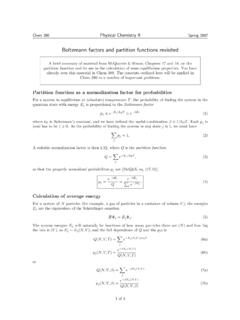Transcription of HÜCKEL MOLECULAR ORBITAL THEORY - MIT …
1 physical chemistry Lecture #31. 1. H ckel MOLECULAR ORBITAL THEORY . In general, the vast majority polyatomic molecules can be thought of as consisting of a collection of two electron bonds between pairs of atoms. So the qualitative picture of and bonding and antibonding orbitals that we developed for a diatomic like CO can be carried over give a qualitative starting point for describing the C=O bond in acetone, for example. One place where this qualitative picture is extremely useful is in dealing with conjugated systems that is, molecules that contain a series of alternating double/single bonds in their Lewis structure like 1,3,5 hexatriene: Now, you may have been taught in previous courses that because there are other resonance structures you can draw for this molecule, such as.
2 That it is better to think of the molecule as having a series of bonds of order 1 rather than 2/1/2/1/ MO THEORY actually predicts this behavior, and this prediction is one of the great successes of MO. THEORY as a descriptor of chemistry . In this lecture, we show how even a very simple MO approximation describes conjugated systems. Conjugated molecules of tend to be planar, so that we can place all the atoms in the x y plane. Thus, the molecule will have reflection symmetry about the z axis: z Now, for diatomics, we had reflection symmetry about x and y and this gave rise to x and y orbitals that were odd with respect to reflection and.
3 orbitals that were even. In the same way, for planar conjugated systems the orbitals will separate into orbitals that are even with respect to reflection physical chemistry Lecture #31. 2. and z orbitals that are odd with respect to reflection about z. These z orbitals will be linear combinations of the pz orbitals on each carbon atom: z In trying to understand the chemistry of these compounds, it makes sense to focus our attention on these z orbitals and ignore the orbitals . The z orbitals turn out to be the highest occupied orbitals , with the orbitals being more strongly bound.
4 Thus, the forming and breaking of bonds as implied by our resonance structures will be easier if we talk about making and breaking bonds rather than . Thus, at a basic level, we can ignore the existence of the orbitals and deal only with the orbitals in a qualitative MO THEORY of conjugated systems. This is the basic approximation of H ckel THEORY , which can be outlined in the standard 5 steps of MO THEORY : 1) Define a basis of atomic orbitals . Here, since we are only interested in the z orbitals , we will be able to write out MOs as linear combinations of the pz orbitals .
5 If we assume there are N carbon atoms, each contributes a pz ORBITAL and we can write the th MOs as: N. = ci pzi i=1. 2) Compute the relevant matrix representations. H ckel makes some radical approximations at this step that make the algebra much simpler without changing the qualitative answer. We have to compute two matrices, H and S which will involve integrals between pz orbitals on different carbon atoms: H ij = p zi H pzj d Sij = pzi p zj d . The first approximation we make is that the pz orbitals are orthonormal. This means that: 1 i = j Sij =.
6 0 i j physical chemistry Lecture #31. 3. Equivalently, this means S is the identity matrix, which reduces our generalized eigenvalue problem to a normal eigenvalue problem Hic = E Sic Hi c = E c . The second approximation we make is to assume that any Hamiltonian integrals vanish if they involve atoms i,j that are not nearest neighbors. This makes some sense, because when the pz orbitals are far apart they will have very little spatial overlap, leading to an integrand that is nearly zero everywhere. We note also that the diagonal (i=j) terms must all be the same because they involve the average energy of an electron in a carbon pz ORBITAL : H ii = p zi H p zi d.
7 Because it describes the energy of an electron on a single carbon, is often called the on site energy. Meanwhile, for any two nearest neighbors, the matrix element will also be assumed to be constant: H ij = pzi H pzj d i,j neigbors This last approximation is good as long as the C C bond lengths in the molecule are all nearly equal. If there is significant bond length alternation ( single/double/single ) then this approximation can be relaxed to allow to depend on the C C bond distance. As we will see, allows us to describe the electron delocalization that comes from multiple resonance structures and hence it is often called a resonance integral.
8 There is some debate about what the right values for the , parameters are, but one good choice is = eV and = .7 eV. 3) Solve the generalized eigenvalue problem. Here, we almost always need to use a computer. But because the matrices are so simple, we can usually find the eigenvalues and eigenvectors very quickly. 4) Occupy the orbitals according to a stick diagram. At this stage, we note that from our N pz orbitals we will obtain N orbitals . Further, each carbon atom has one free valence electron to contribute, for a total of N electrons that will need to be accounted for (assuming the molecule is neutral).
9 Accounting for spin, then, there will be N/2. occupied MOLECULAR orbitals and N/2 unoccupied ones. For the ground state, we of course occupy the lowest energy orbitals . 5) Compute the energy. Being a very approximate form of MO THEORY , H ckel uses the non interacting electron energy expression: physical chemistry Lecture #31. 4. N. Etot = Ei i =1. where Ei are the MO eigenvalues determined in the third step. To illustrate how we apply H ckel in practice, let's work out the energy of benzene as an example. 1. 6 2. 5 3. 4. 1) Each of the MOs is a linear combination of 6 pz orbitals c1.
10 C2 . 6 c . = ci pzi c = 3 . i=1 c4 . c . 5 . c6 . 2) It is relatively easy to work out the Hamiltonian. It is a 6 by 6 matrix. The first rule implies that every diagonal element is : .. H= .. The only other non zero terms will be between neighbors: 1 2, 2 3, 3 4, 4 5, 5 6 and 6 1. All these elements are equal to : .. H= .. All the rest of the elements involve non nearest neighbors and so are zero: physical chemistry Lecture #31. 5. 0 0 0 .. 0 0 0 . 0 0 0 . H= . 0 0 0 . 0 0 0 .. 0 0 0 . 3) Finding the eigenvalues of H is easy with a computer.



















